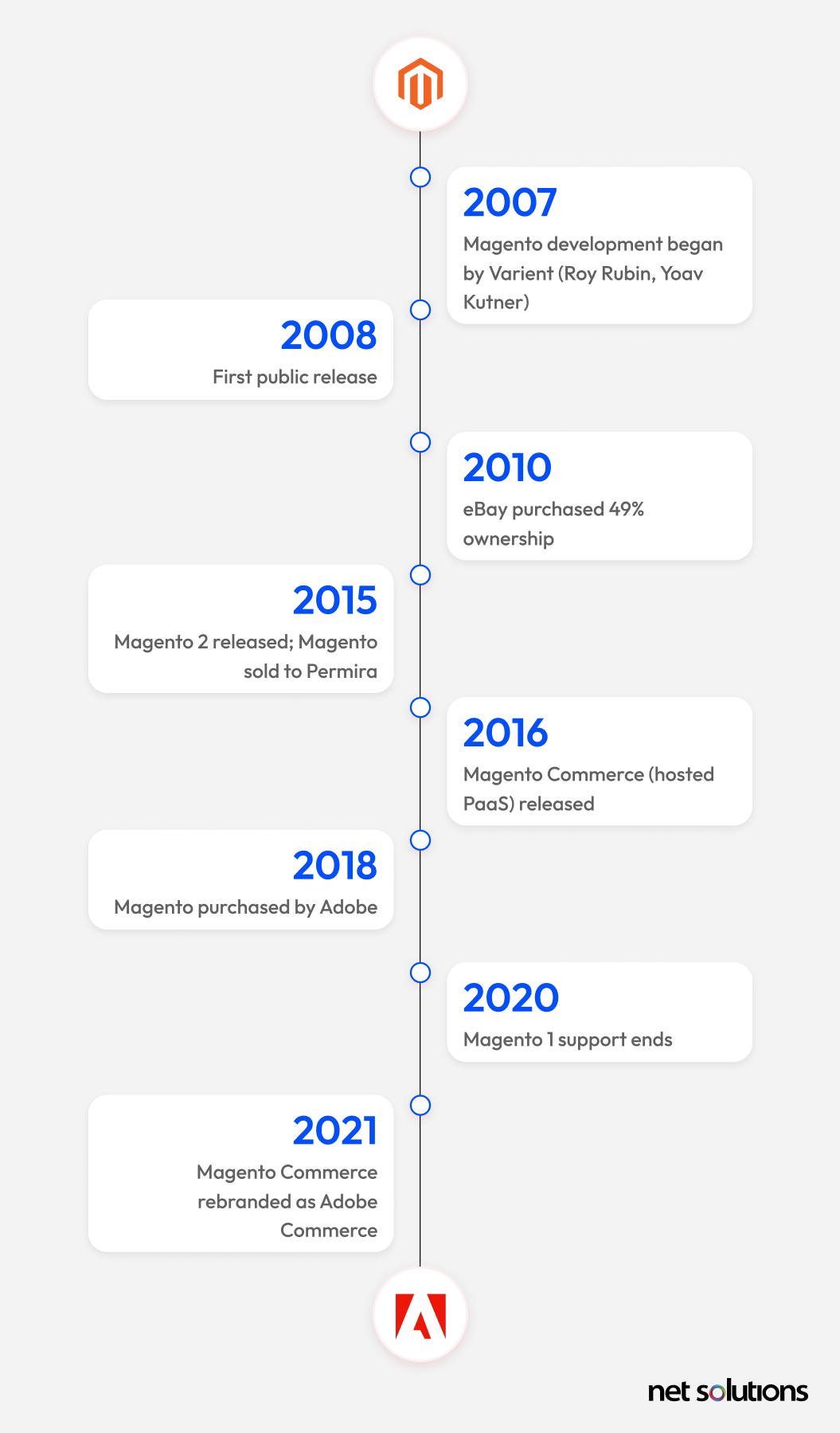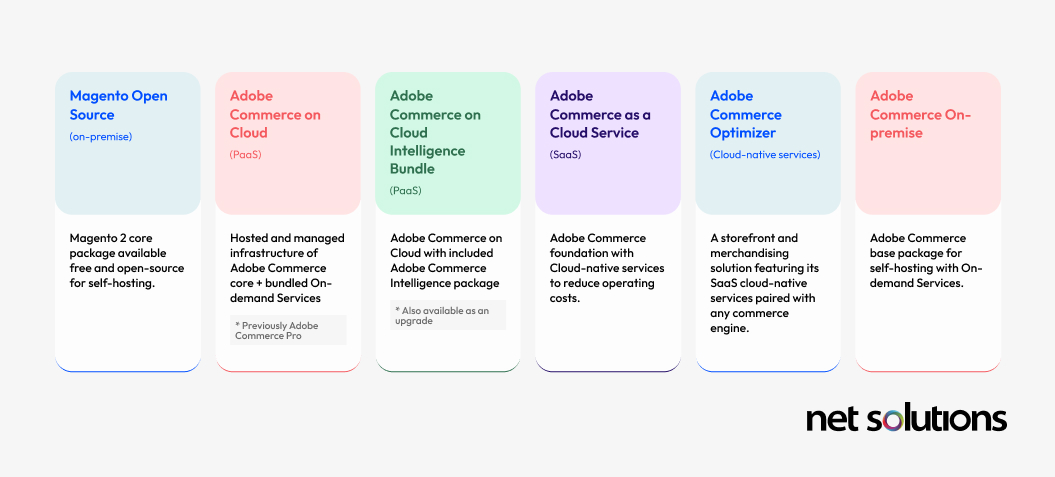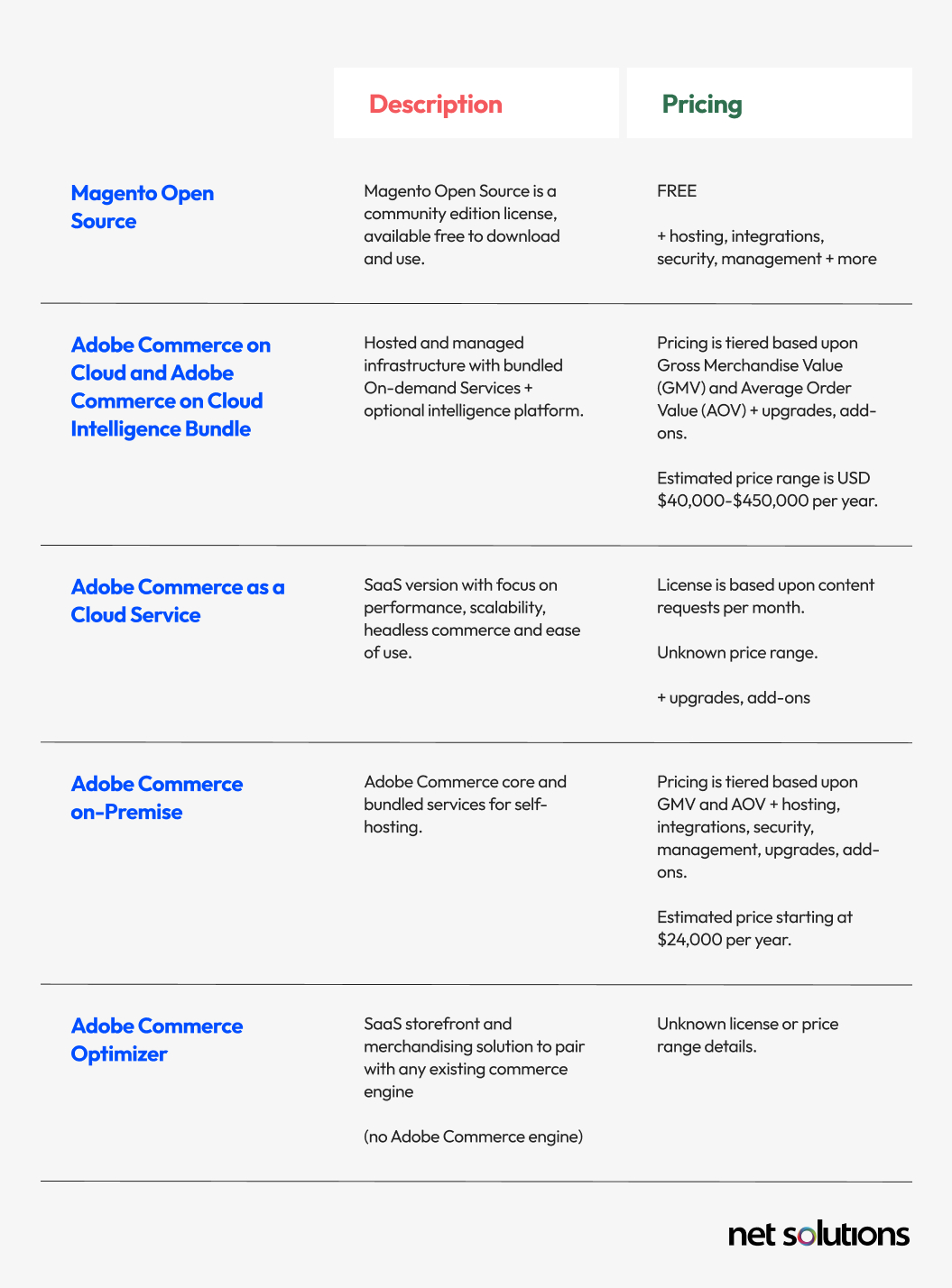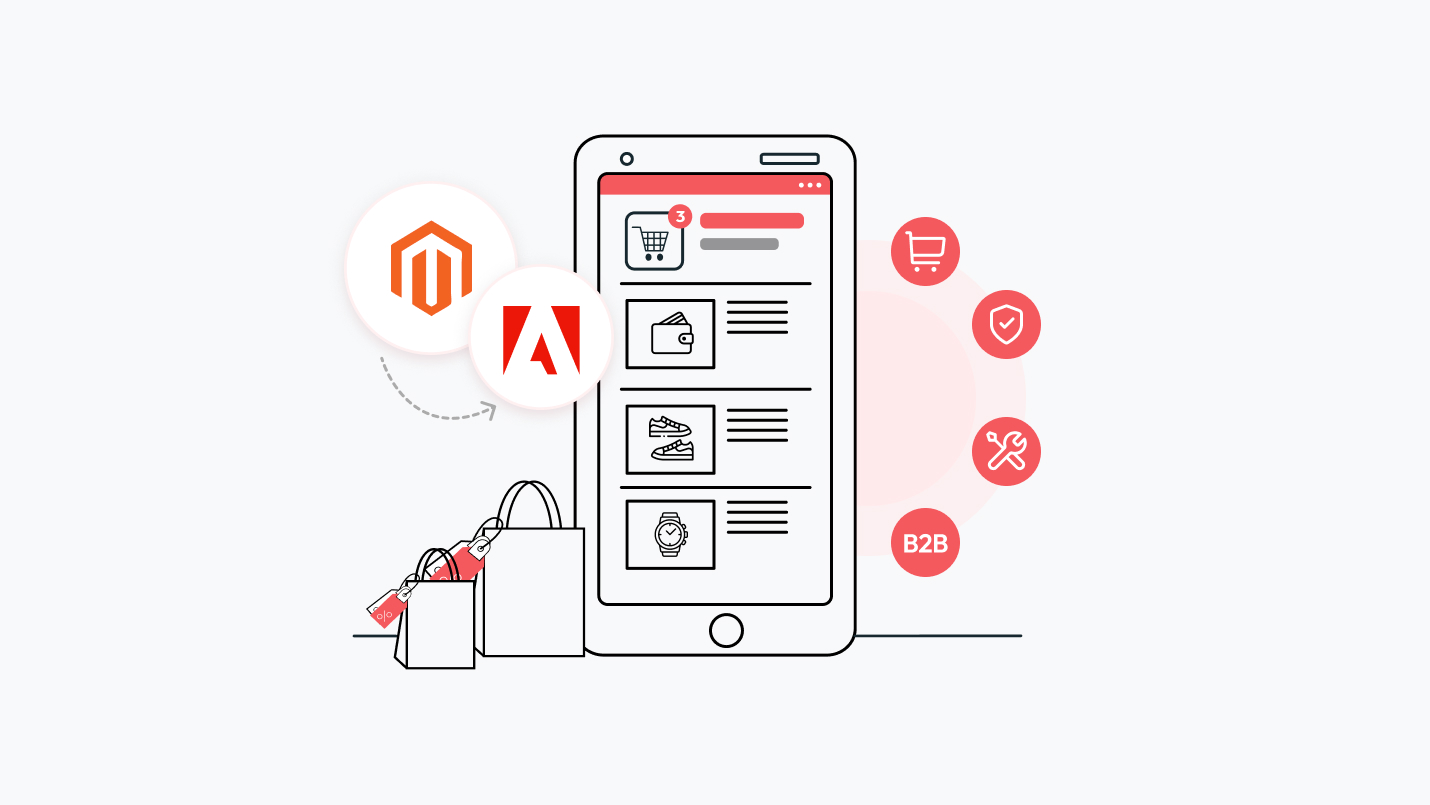Introduction to Magento
What is Magento?
Magento is an Open Source eCommerce platform, first developed in early 2007 and acquired by Adobe in 2018, who later rebranded a premium version of Magento as Adobe Commerce. Today, the Magento platform makes it easy to sell to anyone, anywhere with insight into how you’re doing, tools to make experiences richer and more personalized, and a range of third-party applications to extend the platform.
In 2025, over 95,000 online stores around the world use Magento or Adobe Commerce, nearly one third of which are in the United States. Magento Open Source powers global brands such as Carhartt and Manolo Blahnik, while Adobe Commerce has helped Coca-Cola, Nissan, and Lenovo deliver transformative results.
The Evolution of Magento (From Open Source to Adobe Commerce)
Developed in 2007 and purchased by Adobe in 2018, Magento has consistently attracted recognition, from millions of downloads to its industry-leading recognition as a global leader for complete eCommerce capabilities. What started simply as “Magento” has undergone many brand name changes, and products continue to evolve. The major timeline from Magento to Adobe Commerce includes:

Today, the Magento eCommerce platform remains freely available as Magento Open Source while Adobe Commerce is available by license (on-premise or cloud). While Adobe Commerce shares the same base code as Magento Open Source, it has evolved to include composable services, AI, and advanced features to help create personalized B2B and B2C experiences at scale.
Why Choose Magento for Your eCommerce Store?
Any Magento-based store is designed for scalability, one of its strongest capabilities. The Magento core is optimized for performance, helping ensure businesses can reach target KPIs for product page loads, cart and checkout experiences. All Magento stores also benefit from the capability to handle huge inventories or customer databases, a large ecosystem of extensions, frontend flexibility using a decoupled frontend or headless architecture, and the ability to handle multiple sites from within one platform.
Of course, you may choose Magento Open Source because it is free, Open Source and offers more control via self-hosting. Or you may choose Adobe Commerce because of its deep integration within the Adobe ecosystem or its industry-leading B2C and B2B capabilities, particularly around AI advancements and new composable capabilities. In the next section, we will offer a more in-depth comparison of Magento Open Source vs Adobe Commerce.
Choosing the Right Edition: Magento Open Source vs. Adobe Commerce
Magento Open Source is the core code base, offering all the basic capabilities to run an eCommerce store and some advanced capabilities such as the PWA Studio to develop progressive web application (PWA) storefronts. Magento Open Source is free and self-hosted, giving you freedom to customize your tech stack with no vendor lock in.
Adobe Commerce is a core eCommerce platform that shares the same code base as Magento Open Source, but with advanced features and bundled services added to its core capabilities. Adobe Commerce is available as platform-as-a-service (PaaS), in a new software-as-a-service (SaaS) offering, or standalone as an on-premise offering. Adobe also recently released the Adobe Commerce Optimizer, a series of on-Cloud storefront and merchandising tools that can be paired with any commerce engine as a back-end.
Beyond the base package, Adobe Commerce offers On-demand Services such as the B2B Module, Healthcare Add-on, Adobe Commerce Intelligence, and Edge Delivery Services to optimize for high performance headless deployments and expanded authoring capabilities.

Adobe Commerce on Cloud is designed to unlock performance and scalability and open up new opportunities through composable commerce, B2B, and development optimization. IDC estimates that organizations that switch from Magento Open Source to Adobe Commerce will receive a 516% ROI within 3 years.
What Makes Magento Different From Other Platforms?
As a core platform, Magento offers the ability to centrally manage all your commerce activity and to scale as your business grows—as well as to seamlessly grow within the Adobe ecosystem, moving from Magento Open Source to Adobe Commerce when business models change or in response to a demand for more advanced capabilities. In general, let’s have a look at what makes Magento stand out from the competition:
| Platform | Differences | Platform Chosen By |
|---|---|---|
| Magento Open Source |
|
|
| Shopify |
|
|
| BigCommerce |
|
|
| WooCommerce |
|
|
CocaCola manages its global brand—which includes over 1,000 websites for 100 countries and over 2,200 customer segments—on Adobe Commerce, moving from fragmented tech stacks to a single platform for growth, using Adobe’s advanced personalization tools to see a 36% increase in revenue. Other brands also note increases in organic search conversion, time to market, conversion and top-line growth.
What Are the Benefits of Magento?
Why should you choose Magento Open Source or Adobe Commerce to support your business? Expanding the ‘Why Choose Magento’ section above, we have put together a list of the 11 biggest benefits of Adobe Commerce (Magento) for eCommerce brands, which includes a look at:
- Scalability and performance metrics
- The ability to customize
- The benefit of choosing self-host or managed options
- The large and diverse availability of extensions in the Adobe Commerce marketplace
- Some of the newest marketing tools
- … and more
The Top Features of Magento and Adobe Commerce
Both the Magento core and the premium Adobe Commerce core have continually been updated over the past few years, each year releasing new innovations leveraging Adobe’s investments in AI (Adobe Sensei), frontend flexibility, drag-and-drop Page Builder, digital storefront accelerators and comprehensive B2B commerce capabilities.
| Feature | Magento Open Source | Adobe Commerce on Cloud |
|---|---|---|
| Multi-store, multi-source inventory support | ✓ | ✓ |
| Catalog management | ✓ | ✓ |
| Marketing tools | ✓ Basic: Promotions, coupons, SEO, stock availability, up-sell | ✓ Advanced: Promotional offers, coupons, segmentation, loyalty programs, wish lists, abandoned cart emails, A/B testing |
| Editing tools | ✓ Basic: Page Builder supported | ✓ Advanced: GenAI services, Page Builder supported |
| Localization | ✓ | ✓ |
| Security tools | ✓ Basic: Self-Managed | ✓ Advanced: Managed Service PCI Level 1, SOC2 |
| One-page checkout | ✓ | ✓ |
| Built-in payment options | ✓ PayPal | ✓ Payment Services for Adobe Commerce (Add On) |
| Order management | ✓ Basic | ✓ Integration with IBM Sterling (Add On) |
| Customer account management | ✓ | ✓ |
| 3rd party integrations | ✓ | ✓ |
| Analytics | ✓ Basic | ✓ Advanced |
| CMS | ✓ Basic | ✓ Enhanced CMS with drag-and-drop capabilities |
| Merchandising tools | ✓ Basic | ✓ Adobe Sensei for Live Search and product recommendations, category merchandising, analytics |
| Architecture & frontend support | ✓ Coupled, PWA Studio | ✓ Coupled, PWA Studio, Digital storefront tools (SDKs, App Builder, ready components) |
| Single-tenant, dedicated infrastructure | ✓ | |
| Support services | ✓ | |
| Performance optimization | ✓ Varnish CDN, monitoring, image optimization | |
| Disaster recovery and data retention | ✓ | |
| B2B commerce operations | ✓ Advanced | |
| Digital storefront (pre-built) | ✓ | |
| Data Management Dashboard | ✓ | |
| Adobe Commerce on Cloud Intelligence | ✓ (Different package license) | |
| Healthcare configuration | ✓ HIPAA-ready (Add on) | |
| Edge Delivery Services | ✓ (Add on) | |
| Order Management | ✓ (Add on) | |
| Developer tools | ✓ App Builder, integration starter kits, API Mesh, webhooks, data ingestion starter kits |
Magento in Action: Popular Brands Using Magento
While we’ve mentioned some of the global brands using Magento products (e.g. CocaCola), each brand has a different story to tell about why they’ve chosen Magento Open Source or Adobe Commerce.
In our post, 11 Great Magento Websites By Top eCommerce Brands, we look at some top brands using Magento, analyzing:
- The scope of their implementation (How many sites? How many languages? How many SKUs?)
- What each brand is doing right to capture audience attention
- Any known integrations
- Any published results or quotes about their experiences using Magento
While some eCommerce platforms are very retail oriented, Magento sites are used by a wider net of industries. Our post looks across retail (home, beauty, fashion), telecommunication, automotive, and IT. Magento also has applicable uses in the most regulated sectors, including healthcare, government and financial services, with Adobe Commerce offering both HIPAA-compliant add-ons and certifications in SOC2 and PCI Level 1.
Understanding the Costs: How Much Does Magento Cost?
The cost of your Magento implementation will depend on the product you’re implementing, whether it’s the free Magento Open Source or one of the licensed Adobe Commerce products. In each case, it is critical to take into account any costs that go beyond the product, which could include hosting, security, extensions, add-ons, or upgrades.

Key Integrations: CRM, ERP, and Third-Party Tools
When it comes to Magento, one of the top selling points is the ability to customize your tech stack, whether that’s connecting to your systems of record (e.g. your CRM or your ERP) or expanding platform capabilities through third-party tools.
Here are some critical things to know about integrating with Magento:
There are over 4000 third-party integrations available in the Adobe Commerce marketplace, including the 8 Top Adobe Commerce (Magento) CRM Integrations for Your Business in 2025
App Builder is an extensibility framework for integrating and creating custom applications
API Mesh makes it easy to integrate third-party APIs with Adobe products (e.g. App Builder) in a low/no-code way
At the enterprise level, Contentful provides custom pricing, including dedicated support, service-level agreements (SLAs), and premium add-ons such as advanced security or Contentful Studio. Monitoring your usage (like API calls and storage) is essential to avoid unexpected costs. Many teams set up usage dashboards or alerts to monitor spending.
Magento Development and Performance Optimization
For brands looking to kick start a Magento project on Magento Open Source or to migrate to Adobe Commerce, there are many development considerations. We’ve tried to break those down into different areas as follows:
How to build a Magento Open Source Website
A Step-by-Step Guide to Building a Magento Open Source Website, including how to ensure you meet Adobe system requirements, basic installation information, where to start with customization and extensions, and how to set up basic functionality such as categories and payments.
Migrating to Magento 2
A guide to help Magento users migrate to Magento 2, which is still thousands of you! We know it’s a daunting task, so we’ve put together a comprehensive guide on Magento 1 to Magento 2 Migration.
Magento Best Practices for Development in 2025
As a certified Adobe Solution Partner, we’ve put together our take on the 13 Key Magento Best Practices for Development in 2025, a list of areas we help clients recover from, including performance issues, security concerns, SEO challenges, and integration issues.
15 Tips to Speed Up Magento Open Source Performance
Despite built-in performance capabilities, there are many ways you can inadvertently cause your site to be slow. We share our list of the 15 Tips to Speed Up Magento Open Source Performance, covering everything from hosting and cache management to image optimization and our favorite tools for speed.
Challenges of Using Magento or Adobe Commerce
Performance issues
Large catalogs and their impact on frontend and backend performance, cache management, hosting and server location, excessive promotions and price rules, bot traffic, code inefficienciesSecurity issues
Misconfigurations and mistakes including insufficient authentication, outdated software, PCI complianceUser Experience issues
Challenges related to personalization, stock management, bloated themes and workflows and front-ends (particularly mobile!)Magento Development Trends in 2025
eCommerce is an ever-shifting technology landscape, influenced by consumer trends and technology innovation. From headless and composable commerce to PWAs and GenAI, we’ve put together a list of the Top Adobe Commerce (Magento) Development trends in 2025 to help you determine what’s important to pay attention to. Some of the hottest topics include:
Headless and composable commerce
The need to support multiple front-ends with greater performance and optimized capabilities, with specific information about using Adobe’s API Mesh, App Builder and more.
AI and GenAI
Why AI and GenAI are shaking up eCommerce in everything from content generation, image optimization and workflow assists to AI tools that target the consumer. We’ll take a look at Adobe’s SenseiAI, one of the earliest and most powerful AI tools for commerce, which includes:
- Live Search
- Intelligent re-ranking of search results
- Product recommendations
- Segment-specific content and promotions
- GenAI tools for content authors
These features are currently available only in Adobe Commerce products.
Progressive Web Apps (PWAs)
A progressive web application or app (PWA) is a way of delivering app-like experiences across both mobile and desktop, helping make sites more responsive to the needs of consumers. In the above guide, we will further detail what a PWA is, why people use it, and information about Adobe’s PWA Studio to help developers quickly build and launch PWA storefronts.
Hiring the Right Magento Expert
Magento has changed a lot from its inception in 2007, changing with the demands of the time and with the needs of its eCommerce clients. The way you can use Magento is also endless, making it difficult to know what to implement, how to customize, and how to optimize for performance.
How to find the right Magento Development Partner for your eCommerce transformation
An experienced Magento developer can help you decide between Magento Open Source and Adobe Commerce, help design your architecture, or help you migrate from your existing eCommerce platform. If you’re ready to hire a Magento Developer, here are our tips for you:
- Know your requirements
- Look for certifications
- Check for experience (portfolio, reviews, history of on-time projects, security certifications)
- Look at how the partner communicates (and if there are time zone issues)
- Look for companies with a track record of post-project support and training
What are some best Magento Development Companies?
If you’re ready to hire a partner, we’ve put together a list of some of the Best Adobe Commerce (Magento) Development Companies in 2025 or even the top Magento Development companies in India (yes, our competition), including third-party review information, service expertise, certification information and a general look at pricing.
Ready to Get Started?
Magento Open Source and Adobe Commerce both benefit from significant resource investments – through both the Open Source community and Adobe’s large team of developers. With aggressive timelines and regular updates, you know that working with each product can reliably provide performance, scalability, and an ever-evolving set of tools to meet your eCommerce needs.
In this guide, we have examined Magento products extensively, from their benefits and features to how they stack up against the competition. As a certified Adobe partner, Net Solutions is here to help you succeed with your Magento project – from scratch, upgrading, replatforming or optimizing.



